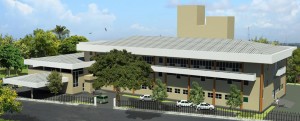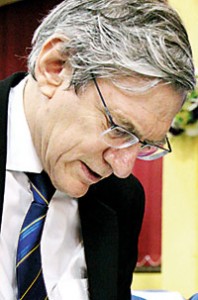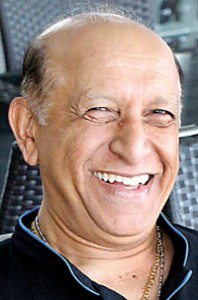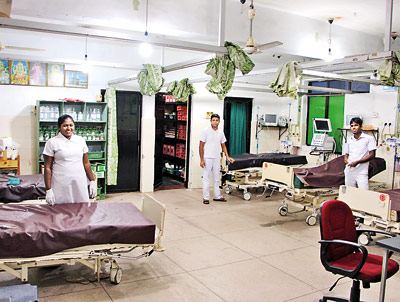Vision in ink for Batti hospital soon a reality
In Batticaloa, it’s one of those heavy grey days punctuated with intermittent showers. The rains have cast a momentary cloud but the air is thick with anticipation for the afternoon’s proceedings on Friday, November 13 at the Batticaloa Teaching Hospital.

What it will look like: 3D visualisation of the new unit
Pockets of people have thronged sections of the hospital, awaiting the dignitaries for the day and the weather has played its part in pushing back the proceedings.
There are two new sections of the hospital to be opened and the ground has been cleared to lay the foundation stone for a new Emergency and Accident Unit for the hospital.
For the team behind the Batticaloa Emergency Accident Project (Project BEAP), the day has been a crucial one, that has been years in the making.
Laying the foundation stone for the Batticaloa Teaching Hospital’s new Emergency and Accident Unit means that a paper and ink vision will soon achieve a brick and mortar tangibility.
The project BEAP team brings together a host of colourful personalities across varying professions from Australia and Sri Lanka, all of whom have united for a common cause: to improve the trauma services in regional Sri Lanka.
Project BEAP takes to heart the oft-quoted John Kennedy maxim, “ask not what your country can do for you, ask what you can do for your country” and is a partnership bridging Sri Lanka’s private and public sectors.
The project comes under the umbrella of the Foundation Supporting a National Trauma Service in Sri Lanka. Established in 2011, the Foundation seeks to empower doctors in Sri Lankan Teaching Hospitals, providing them with the necessary infrastructure, resources and training to augment regional medical services.

Dr. David Young
In addition to Project BEAP, the Foundation teaches and trains surgeons and delivers equipment requested by surgeons to teaching hospitals around the island.
The Foundation’s beginnings are rooted in cricket and the 2004 tsunami. President of the Foundation Supporting a National Trauma Service in Sri Lanka, Dr. David Young is an orthopaedic surgeon based in Australia, and has been the orthopaedic consultant to the Sri Lankan cricket team for the past 21 years. During the initial years, Dr. Young realised that he couldn’t just be surgeon for the cricket team without giving back to the country as a whole.
Soon, he started lecturing and assisting local surgeons while providing necessary equipment required for regional hospitals.
Later, Dr. Young was also active in obtaining funding from the Victorian Government to assist the development of the Karapitiya Hospital.
In 2004, when the brown-grey waves of the Boxing Day tsunami receded, they left a splintered world in their wake. The U.S Geological Survey later said that it believed the 9.0 magnitude earthquake had released energy equivalent to 23,000 Hiroshima-type atomic bombs.
Lives were lost in the charging rapids, the battered survivors were in need of urgent medical attention and in parts of the island, the destruction had rendered the landscape unrecognisable. With the war going on, aid and medical relief posed an additional challenge in parts of the country.
When Dr. Young reached the East Coast of Sri Lanka a few days after the tsunami to assist medical efforts, the scenes which confronted him at the Batticaloa Hospital were disquieting.

Nihal de Run
The central trauma hospital for the area was grossly understaffed and under-equipped and the hospital struggled to deal with the swelling numbers pouring in.
The experience was a sobering eye-opener. It was then that he realised how the lack of strong medical services can undo a country and vowed to come back to make sure this was prevented.
In 2011, Dr. Young met Nihal de Run, a Sri Lankan who migrated to Australia, and shared his vision for improving Sri Lanka’s regional trauma services.
With the end of the war enabling greater access around the island, the Foundation was formed, more people joined in to help, partnerships were forged and work began to snowball.
The Sunday Times sat down with Dr. Young and Nihal de Run a few hours after the foundation stone for the Emergency and Accident Unit was laid in Batticaloa.
It’s been a long but satisfying day. Nihal de Run, CEO of Project BEAP, is relieved that after months of shadow boxing, the project has achieved tangible progress and is grateful for the support rendered so far.
“One of the areas we struck trouble was the scepticism,” muses Nihal who concentrates on fundraising activities and forging stronger private-public sector partnerships.
“Now, we have less resistance because we have got something that has literally started.” Unlike isolated short-term philanthropic efforts between the private and public sector, the project focuses on longevity and would like the ripple effects to extend to other parts of the island.
“Any medical emergency – heart attack, labour, poisoning, overdose, suicide attempts or a vehicle accident – goes to a triage in place in a casualty department to get immediate care.

The Batticaloa Hospital: Serving a great need in the East
And instant care is the best sort of intervention you can have in an emergency,” says Dr. Young, emphasising the importance of good, timely emergency services, especially in light of the East Coast’s emergent tourism sector.
The completed Emergency and Accident Unit will be designed to handle multiple casualties resulting from mass trauma. The unit will consist of triage with immediate accessibility, Resuscitation and state-of-the-art emergency treatment areas, diagnostic facilities as well as male & female wards and operating theatres.
Plans are also in the pipeline to regularly bring down a team of volunteer surgeons and doctors to assist in volunteer work.
Batticaloa Hospital Director, Dr. M. Ibralebbe, explains that the hospital now attracts growing numbers from the Eastern province and surrounding districts to its specialised units.
Initially a Provincial General Hospital, it was upgraded as a Teaching Hospital to cater to the Eastern University’s Faculty of Medicine in November 2006.
“This is the only place in the Eastern province and the adjacent area where you have surgeons such as neurosurgeons and plastic surgeons so all trauma cases from the entire region are referred here.
We have a big number of patients to treat and nowadays most of the patients are transferred to Colombo and Kandy if there are no facilities,” says Dr. Ibralebbe.
He adds that most of the hospital’s buildings are more than 60 years old and the upcoming Emergency and Accident facilities would go a long way in providing a greater degree of emergency care and a conducive learning environment.
| Want to support the project?The construction of the Emergency and Accident Unit at the Teaching Hospital, Batticaloa is scheduled to begin this month by the Central Engineering and Consulting Bureau of Sri Lanka (CECB). The 24 month project is designed by Gunaratna Associates, Architects for the project, and construction is estimated to cost Rs. 807 million plus VAT. Project BEAP’s contribution to the construction is Rs. 260 million, while the balance will be funded by the Government. So far, Rs. 200 million (inclusive of pledges) has been raised by Project BEAP through donors and corporate sponsors who have come forward to support the improvement of the medical services in the area. Those interested in supporting the project, please contact nihal@derun.net.au or visit http://www.projectbeap.org/ for more information. The Foundation Supporting a National Trauma Service was established as a trust with Dr. David A. Young, Nihal de Run, Nalin Pathikirikorale, Indrajith Fernando and Yoland (Bobby) Hansen as its trustees in Colombo. It was also granted legal status in Australia. Former Governor of Victoria, Prof. David de Kretser, serves as patron while Dr. Ranjith Hettiarachchi and Abbas Akbarally serve as vice patrons. Cricket’s Superstars Muttiah Muralidharan, Kumar Sangakkara, Dav Whatmore and Shane Watson serve as ambassadors for the project. |


